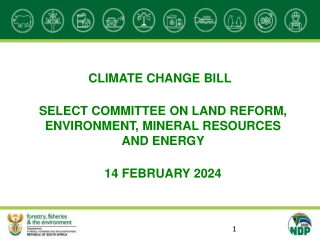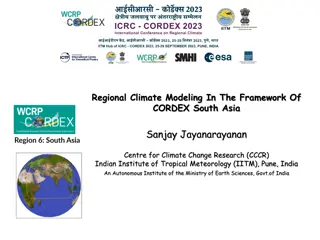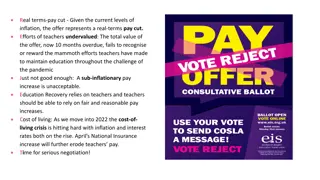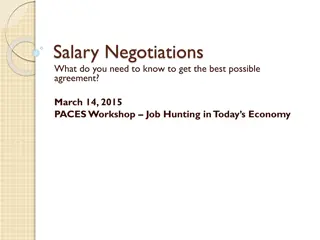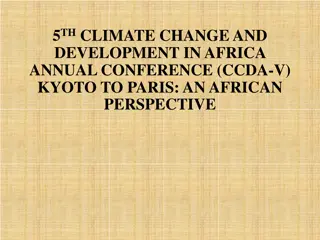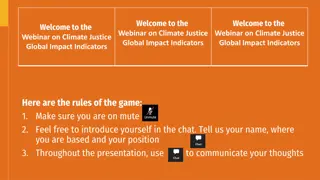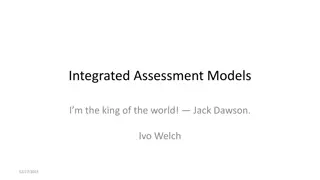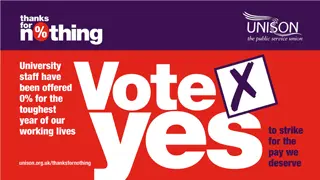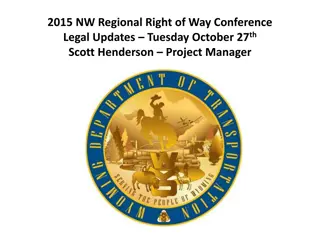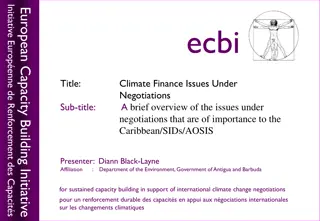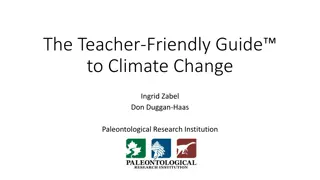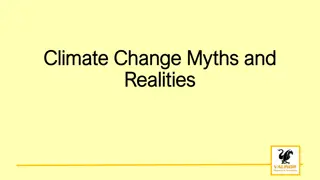
Revolutionizing Climate Action Through Carbon Pricing
Explore the transformative impact of implementing carbon pricing to address climate change challenges. Learn about the history, effectiveness, and global implications of carbon pricing policies as endorsed by economists and Nobel Laureates. Discover the innovative idea of adopting a global carbon price for a more efficient and sustainable climate strategy.
Download Presentation

Please find below an Image/Link to download the presentation.
The content on the website is provided AS IS for your information and personal use only. It may not be sold, licensed, or shared on other websites without obtaining consent from the author. If you encounter any issues during the download, it is possible that the publisher has removed the file from their server.
You are allowed to download the files provided on this website for personal or commercial use, subject to the condition that they are used lawfully. All files are the property of their respective owners.
The content on the website is provided AS IS for your information and personal use only. It may not be sold, licensed, or shared on other websites without obtaining consent from the author.
E N D
Presentation Transcript
Dont Blame the Negotiators Change the Climate Game: Price Carbon 5 May 2014 3rd Mannheim Energy Conference Steven Stoft For details see: carbon-price.com 1
A Short History of Carbon Policy 1974 The first carbon crisis (oil) IEA formed. Quantity limits failed. Switched to price. OPEC pushed the price higher. The best climate policy ever & OPEC was squashed. 1988 Cap & trade was invented because Economists want a price Environmentalists want caps (= command and control) Caps failed in Kyoto (1997) and Copenhagen (2009) Environmentalists have thrown out price Leaving sporadic regional volunteerism Weitzman Earth is cooked (2099) 2
Carbon Pricing Is Powerful 10 OPEC's $ Trillions CarbonPricing Policy 8 GT 6 Trends continue until 2002 4 Price per Barrel 2 0 1960 1973 1986 1999 Nuclear assumed to emit 1 tonne CO2 / MWh 3
Quiz: Whats the cost of a price? Say the US is emitting 5 Gt (Billion tonnes). It imposes a $30/t carbon tax. Emissions drop to 4 Gt. How much does this cost the US? a) $0 to $25 Billion / year b) $25 to $50 Billion / year c) $50 to $100 Billion / year d) $100 to $150 Billion / year e) None of the above 4
Carbon Pricing Is Cheap Carbon tax revenues are all used or returned. Everyone gets at check = ($30 4 billion)/pop. 120/0.3 = $400 per year per person. The tax is free. But the abatement is costly. 1 billion tons abatement at a cost of $0 to $30/ton $15 Billion $50 per person per year. (7 /day) 5
Economists' Statement on Climate Change Released on March 29, 1997. Endorsed by over 2500 economists, nine Nobel Laureates: The United States and other nations can most efficiently implement their climate policies through market mechanisms, such as carbon taxes or the auction of emissions permits. http://rprogress.org/publications/1997/econstatement.htm 6
Now, Heres the New Idea 1. Country s should NOT commit to individual caps or try a global capping formula. 2. They should commit to a global carbon price. Why is this new? Because a global carbon price has a new meaning. 7
A Global Carbon Price One old meaning: Another old meaning: Use a harmonized carbon tax. What it really means: You choose whichever you want cap or tax (or a mix). They both give us global carbon price. Use global cap and trade. 8
Why Was that Hard to Figure Out? Because it seems like if you commit to $30/ton you have to use a tax because with a cap, the price is totally unpredictable. So there would be no way to commit. There are a many ways to accommodate caps. See http://carbon-price.com/climate/overview/treaty/cap-trade/ 9
Why Is Cap-or-Tax so Important? 1. Because it avoids the cap-tax fight. 2. A uniform global price with Cap-OR-Tax, is a focal point a point of agreement. 3. And a focal point is the key to cooperation. (Focal point: Thomas Schelling, Nobel prize, 2005) 10
Who Agrees: William D. Nordhaus President, American Economics Association. Has been publishing on climate change since 1977. At a minimum, all countries should agree to penalize carbon and other GHG emissions by the agreed-upon minimum price. Some countries might simply use carbon taxes. Others might implement their commitment using a cap-and- trade mechanism. 11
Who Agrees: Joseph E. Stiglitz Nobel prize 2001. Writing about climate change since 2001. Perhaps it is time to try another approach: a commitment by each country to raise the price of emissions (whether through a carbon tax or emissions caps) to an agreed level, say, $80 per ton. 12
Who Agrees: Martin L. Weitzman Harvard economist specializing in environmental and climate economics The important thing is acquiescence by each nation to a binding minimum price on carbon emissions, Nations or regions could meet the obligation of a minimum price on carbon emissions by whatever internal mechanism they choose: a tax, a cap-and-trade system, a hybrid system, or whatever else results in an observable price of carbon. 13
Who Agrees: Stphane Dion Minister of the Environment for Canada (2006 2008) and Chair of COP 11/MOP 1. We propose: countries would each make a commitment to introduce, in their respective jurisdictions, a carbon price aligned with a scientifically- validated international standard. In pricing carbon emissions through a tax or a cap and trade, of course we must gradually eliminate fossil fuel energy subsidies. 14
Who Agrees? Axel Ockenfels (Director of the Cologne Laboratory for Economic Research. Leibniz Prize in 2005, and Contributing Author for IPCC.) Peter Cramton (Professor of Economics, University of Maryland) loi Laurent (senior economist and scientific advisor at Sciences-Po Center for economic research and visiting professor at Stanford University) Richard N. Cooper (Maurits C. Boas Professor of International Economics at Harvard University.) 15
Why this new approach matters Carbon Pricing is Powerful Cheap Efficient And it s the only way to get a strong agreement. But it has been blocked by the Cap vs. Tax fight. 16
Which Works Better: Caps or Taxes? That misses the point Poor countries will not have caps: At the very least they argue, they should have the right to emit the same amount per capita as the United States. Stiglitz agreement is what matters. But, Europe will not give up cap and trade. So allow caps OR taxes. 17
End of Introduction Now a Systematic Approach 18
Roadmap 1. Climate problem = Free Riding (self interest) 2. Altruism is too weak to stop self interest 3. Instead: Change self interest I will do X if you will. 4. For a public good, X must be a focal point 5. A global price is the only focal point 6. A Green Fund helps poor countries comply 19
#1. The Problem: Climate = Public Good 1. This the only reason for UN negotiations. 2. If the climate were not a public good US emissions would have no impact on the EU Same with China, etc. 3. There s no need for a UN conference to tell the US to clean up smog in Los Angeles! Everyone agrees. 4. The public climate good is: abatement. 5. Everyone free rides on others abatement. 20
#2. Altruism Negotiators tell us the problem is: lack of political will lack of ambition lack of leadership They don t say lack of altruism. That would sound na ve because the world is unlikely to become altruistic by 2015. 21
How well does altruism work? If the United States leads, China will follow. Al Gore (Guardian, 24 April 2009) Leading cooperating first has been checked experimentally. Experimental results range from: It makes free riding a bit worse, to It helps just a bit, but the leader is worse off. Al Gore did not check the science. 22
Why some hope for global altruism Because: People don t know that self interest can be changed. 1. If they knew we could change it from Free ride to cooperate They would stop talking about ambition . 2. You don t need ambition to act in your own self interest. 23
Conclusion #2 Altruism is too weak Climate is like a repeated prisoners dilemma game, but with many prisoners. Many experiments show that, with more prisoners, cooperation is more difficult. 24
So Dont blame the negotiators 1. They are stuck in a repeated prisoners dilemma with 200 prisoners. 2. This is the worst game imaginable. 3. Altruism is too weak a force. So change the game to I will commit to X if you will. Then cooperation will be in most country s self interest. 25
Can We Change Self Interest? Most people think it s impossible. But, changing self interest is the basis of society. We do it all the time! And we solve big public-goods problems: Parks Highways Military Education Toxic cleanup Courts 26
How to Change Self Interest If we don t make an agreement with Starbucks: Starbucks self interest = keep the cappuccino. My self interest = keep my money. So they say: We will give you a cappuccino if you will give us $4. We will if you will. That changes our self interests. 27
To Change Self Interest Make a deal (agreement) Sign a contract Sign a treaty It s that simple. We do it all the time. But for public goods we need a special kind of agreement a common commitment. 28
An Example of a Common Commitment If we want to build highways. Do we put a donation box at every petrol station? Do we ask for altruistic contributions to the highway fund? No, we vote for a common commitment to a price (tax) on gasoline for building highways. When we vote we are saying: I will pay an $X tax if you will. It is in your self interest to vote for $X, but not to put $X in a donation box. 29
Conclusion #3: Change Self Interest To change self interest we need to agree on a Common Commitment, such as: All countries will reduce emissions to 10% below the 2000 level. OR All countries will set an average carbon price starting at $30/ton and increasing. 30
Step 4 1. The problem: Free riding 2. Altruism is too weak 3. Change self interest with a common commitment I will do X if you will. But most common commitments won t work 4. X must be a focal point 31
Whats a Focal Point A focal point is a game strategy that people will tend to use because it seems natural, special or relevant to them.(Concept from Thomas Schelling, Nobel Prize, 2005) It can be a formula: 2010 Emissions = (1 R) (1990 Emissions) That s a partial focal point, but R can be found by majority vote or by consensus. 32
Kyoto searched for a focal point At first, half of the countries wanted: 2010 Emissions = (1 R) (1990 Emissions) But Australia, Hungary et al., Iceland, Japan, Norway, Switzerland and Brazil all submitted different focal-point formulas, based on: GDP/capita growth; emission intensity of GDP and of exports; emissions/capita, GDP/capita, share of renewables, % emission from industry, choice of variables, pledging, relative contribution of CO2. 33
Kyotos Outcome After almost two years in which dozens of proposal must have been considered, there was nothing close to agreement. Chairman Estrada gave up. On the final day he invited Annex I Parties to submit their revised, final numbers to the podium. They submitted whatever they wanted and these numbers were simply inserted into the blank draft annex B. Official UN history, DePledge 2000 http://carbon-price.com/climate/library/related/ 34
Lessons from Kyoto 1. A cap-style focal point does not exist. 2. So a cap-style common-commitment was not made. 3. So self interests were not changed. 4. And the free-rider problem was not solved. For example: When the EU expected uniform formula to be the focal point it offered 15%. When there was no common commitment, it accepted only 8%. Iceland immediately announced its target was unattainable. The rest is history. (US, Canada, Japan, Russia) 35
The Lesson for Paris, 2015 In Kyoto, countries tried pledge and review for almost two years, then committed to whatever they wanted. That s the plan for the Paris Conference, 2015. Paris will fail just like Kyoto and Copenhagen 36
Looking for a Focal Point We know there is no quantity-type focal point. Kyoto proved that. Is there a price formula that s a focal point? 37
#5: A Uniform Price Is Focal Carbon-Price(i) = X For every country i The simplest price formula is focal. Of course, X should increase over time. The whole point of Trading in Cap-and-Trade is a uniform, efficient, global price. The whole point of a Harmonized Tax is a uniform, efficient, global price. Everyone agrees: a uniform price is best. 38
What about Poor Countries? They will agree if they get some help. That fair. So use the Green Fund. This is the best use of a Green Fund: Buy the very best climate policy, a uniform global price. 39
One Way to Buy a High Price Payment Into Green-Fund = G Ex P* G = the generosity of the payments Ex = Excess Emissions. P* = the Global Carbon Price For poor countries, Ex is negative they get paid. So poor countries will agree to a high P* so they will be paid more. Now G can be chosen objectively it should be chosen to maximize the P* consensus. 40
Experiments (work in progress) Axel Ockenfels, Andreas Pollak, Peter Cramton and myself are experimenting on common price and quantity commitments at the Cologne Laboratory for Economic Research. Common Price Commitment Game Carbon-Price(i) = P* Three students (countries) choose a prices, {Pi} P* = Minimum of {P1, P2, P3} = consensus All must implement P*. 41
Experimental Result If there were no common commitment in the game, each country would implement Pi. Then the Nash equilibrium is: Pi = $10. (Theoretical. No data yet.) But with the common commitment, on average the Minimum Pi was $29.30 The optimal P* was $30. I will if you will really works! 42
But We Are Stuck Environmentalists say, Countries must agree to caps. Nothing else will do." Countries cannot find a common cap formula. There is no common commitment. Environmentalists now say, We don t want a price, we're buying wind turbines. Self interest unchanged. Free riding continues. The Earth is cooked. 43
Summary The problem: It s free to emit, so why abate? The theory: Price Carbon and change self interest. Use a common commitment. In practice: 1. Countries agree on a global price path 2. They can use either Caps or Taxes or both 3. A Green Fund helps poor countriesafford this 44


